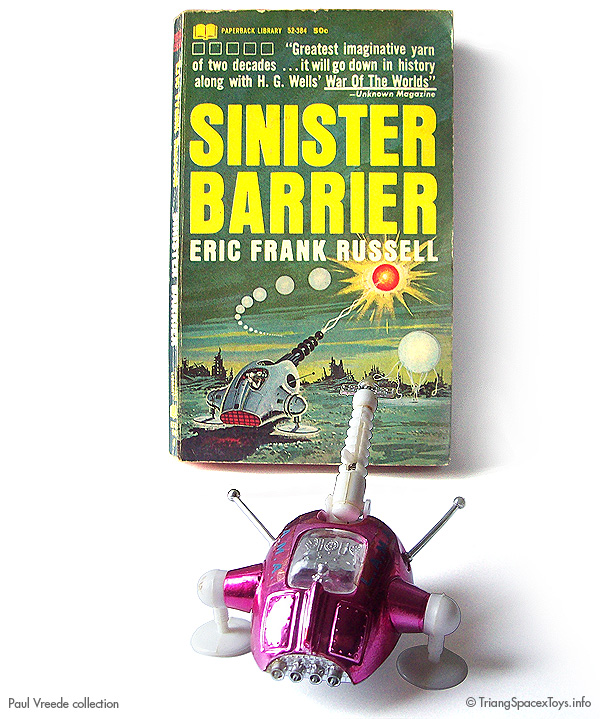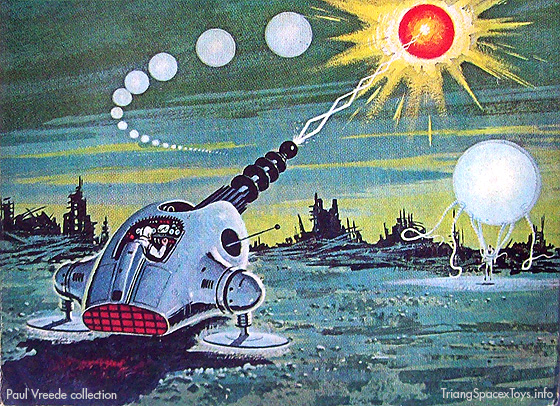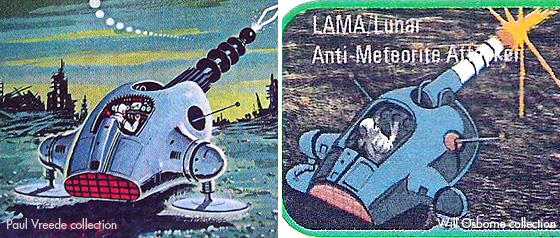
The LAMA is clearly based on the cover illustration by Ed Valigursky for the Paperback Library edition of "Sinister Barrier" by Eric Frank Russell, published in 1966. And, unusual for a pulp sci-fi paperback, the illustration is actually based on the story, though taking it a step further.

Written in 1939 and expanded/updated in 1946, the story is set in 2015. Government agent Bill Graham investigates the deaths of a number of scientists, to eventually find these have become aware of the existence of a higher form of life on Earth. These beings, called Vitons by the scientists, are composed of energy invisible to human eyes, and feed off human emotions. They are telepathic at short range, and influence humans to be in conflict and at war to thus create heightened emotions to feed upon.
The Vitons kill any person that even suspects their existence, but one of the now-dead scientists had invented a combination of drugs and chemicals that increases the visible range a human eye can see. Having obtained the formula, Graham devises a plan to have the US government broadcast it across the world. The Vitons, now visible to anyone with enhanced vision (and looking like the creature seen at right in the cover illustration), retaliate by influencing an Asian alliance to attack and invade the US, the rest of Asia and on to Europe.
Meanwhile, Graham discovers another scientist has found a means of destroying Vitons, at least in theory, but the scientist is killed by Vitons before he arrives. He does find a clue left by the scientist in his final moments, which eventually leads Graham to discover the scientist's idea. He then organises dispersed research units to develop and build a weapon capable of destroying the Vitons through firing a double-helix energy beam.
The Vitons are now aware of the potential danger, and cause their Asian puppets to step up their conquests, while launching the first atomic weapons of the war at any place that might have a research facility. With Europe within 80 hours of total defeat and the US half-way overrun, the first weapon is ready to be tested while components for building more are again dispersed for safety. Graham himself kills the first Vitons before narrowly escaping death as following Vitons destroy the test weapon.
While Graham recovers, details of the weapon are broadcast around the world and soon the Vitons' grip on the Asians is broken, which ends the war. Graham has saved the world (and also gets his girl, one of the secondary characters in the plot).
In the story, Russell describes a few details about the weapon, which Valigursky has used as a starting point for his cover illustration. The barrel appears right, as does the double-helix beam it fires. Everything else will have been invented by Valigursky, especially as there are no craft in the story that are capable of hovering above the ground.
Coming back to the Spacex toy, this is pretty close to Valigursky's craft, different in just a few details (exhausts and antennas). And as Paul Woods pointed out after he discovered this book cover, the artist that did the card-back illustration will have seen Valigursky's original, because exhaust, antennas and smaller details are depicted more as in Valigursky's illustration and not how they appear on the toy.

Note: according to Wikipedia, the basic premise of this story was inspired by the writings of Charles Fort (open in new windows).